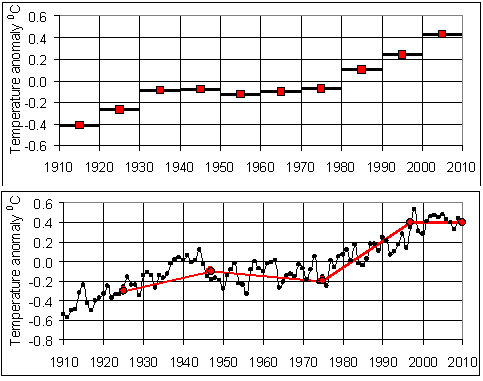Professor Ross Garnaut, in the introduction to his update of the Science of Climate Change asked two econometricians to examine the temperature record in this and the last century. The temperature trend analysis that Garnaut had asked his distinguished colleagues to perform gave him the answer he wanted. There was a continuing increase. But this methodology is widely disputed. For example in a long editorial comment in the journal Climate Change, Terence Mills, a UK econometrician who has written at length on temperature trend analysis, concludes that "Statistical arguments alone are unlikely to settle issues such as these, but neither are appeals to only physical models or the output of computer simulations of coupled general circulation models….it is a case of you pays your money and you takes your choice".
Garnaut's sole reliance on an econometric analysis to interpret temperature changes indicates a failure to recognise the range of possible interpretations of such changes. These are examined below.
The measurements can be presented in a number of ways from monthly to yearly to 10 year values as used by the IPCC. A comparison of annual and 10 year values in Figure 1 shows that reliance on 10 year values, as used by the IPCC, may obscure details that are important and this is true of the last ten years.
Advertisement

Figure 1: Global temperatures estimated by the Hadley Centre of the UK Met Office. Upper: 10 year averages of annual temperatures (IPCC presentations). Lower: Annual values where solid red lines indicate warming and cooling periods. The red dots mark break points for the Pacific Decadel Oscillation.
So Garnaut needs to reconsider his conclusion.
Trend analysis can be used to see if some recognized climate event caused a break in any of the many time series that have been constructed for atmospheric variables. It can also be turned around to seek such a climate event by providing pointers to the climate event from the timing of the break in a trend.
A good example of this approach is to examine the behaviour of the Great Pacific Climate Shift (GPCS) in 1976-77, an overturning of surface water in the North Pacific Ocean. It was first noted from dramatic shifts in salmon production regimes in the North Pacific Ocean. The climate pattern also affected coastal sea and continental surface air temperatures, as well as river flows in major west coast river systems, from Alaska to California. In fact the oceanographers identified three breaks, in 1925, 1947 and 1977 and styled the intervening periods of increasing and decreasing temperatures as warm, cool and warm phases of the Pacific Decadel Oscillation. The oceans are 70% of the earth's surface and the top 14 metres have as much mass as the entire atmosphere and the top 4 metres holds as much heat as the entire atmosphere. They have a major role in determining changes in global temperature
For the GPCS, trend breaks occurred not only in global temperatures but also in CO2 and humidity time series. A three way coincidence is unlikely to be a random event and there was of course an explanation coming from identified ocean changes. Changing surface water changes the surface air temperature and of course the humidity and, just like warming a bottle of soda water, there is a rebalancing of CO2 in the atmosphere.
Advertisement
Figures 1, 2 and 3 illustrate this trend analysis approach. Figure 1 shows one of the global temperature series recognized and used in IPCC publications. A trend analysis on a yearly basis rather than using ten year averages shows breaks in the trend. So there is a break at the end of the 1990s but is the pattern of temperature measurements after 1997 merely "noise" in a continuing rising trend as seen in the 10 year averages of Figure 1.
The way forward is to see if other climate time series measurements show a change at the time of the temperature breaks. The CO2 time series is a good place to look. Figure 2 below show the direct annual measurements of CO2 in the atmosphere at the South Pole while Figure 3 shows the residual differences for each year of CO2 measurement from the trend line in Figure 2.

Discuss in our Forums
See what other readers are saying about this article!
Click here to read & post comments.
29 posts so far.